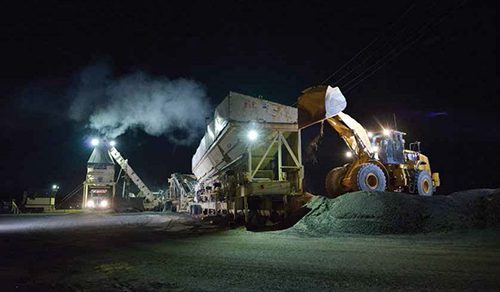How does an airport with just one runway maintain operations while rehabilitating that runway? After nine months of intense and highly coordinated work on Runway 18-36, Myrtle Beach International (MYR) has some answers.
Although the project cannot officially be considered a full reconstruction because base stone was not removed, it was more complex than most mill-and-fill projects. In addition to repaving its 9,500-foot runway, the South Carolina airport also installed new lighting and markings.
 facts&figures facts&figuresPrimary Project: Runway Rehabilitation Associated Projects: New Lighting & Markings Location: Myrtle Beach (SC) Int’l Airport Cost: $19.4 million Timeline: August 2014 – April 2015 Engineer of Record: CHA Consulting Prime Contractor: Anthony Allega Electrical: Atlantic Electric Lighting Fixtures: ADB Airfield Lighting Scope of Installation: 70,000 linear ft. of cable; 20,000 ft. of conduit; 113 runway & taxiway lights Performance Planing: Pavement Products & Services Engineering/Inspection: Castles Engineering Quality Assurance Testing: Terracon Runway Markings: Hi-Lite Airfield Services Major Challenge: Keeping airport operational during rehabilitation of its sole runway |
Engineer of Record CHA Consulting devised the plans for crews to mill off variable depths and construct two variable-depth leveling courses to achieve the proper grades to meet current FAA standards for profile and section. The firm also engineered plans to create a new uniform surface course of asphalt with saw cut grooves for friction and new markings. During paving operations, crews replaced the entire runway edge lighting system and in-pavement lead-off lights for the runway’s two high-speed exits.
Work for each night had to be planned and executed carefully, so the airport could be operational again before the first scheduled flight the following morning, explains Bill Barley, P.E., CHA’s market segment vice president – aviation design. Monday through Thursday, MYR closed its sole runway between 10:45 p.m. and 6:45 a.m. Friday through Sunday, it was out of operation from 11:45 p.m. until 5:30 a.m.
Because work had to be completed during the airport’s off-season – fall, winter and early spring – cold temperatures and other weather issues presented wildcard factors for scheduling purposes.
“Our air traffic is very seasonal,” explains Assistant Director of Airports Jason Terreri. “Our summer months are very busy, so we had to get the project done before the summer push began in May. All of this took a lot of coordination with the airlines and the FAA.”
With nighttime closures beginning in September, airport officials worked closely with the airlines to make the necessary schedule adjustments to ensure that the runway work could be completed, Terreri recalls.
Milling & Paving
Preparation was key to the success of MYR’s project, Barley emphasizes. The project required an onsite asphalt plant, which contractors set up in August. Other preparatory steps included obtaining air quality permits and moving “mission control” items into place.
“We required redundant equipment to make sure we had backups in case of machinery breakdown,” Barley explains. “We were prepared. You do your best with risk management to make sure you have all the people and equipment ready to handle any problems that may pop up once heavy construction begins.”
General contractor Anthony Allega followed suit with contingency planning. “We had backup pavers, backup milling machines, backup everything,” says Jim Allega, the company’s vice president. “The only thing we didn’t have a backup for was the asphalt plant.”
Having extra equipment onsite proved its worth when the engine on a paver blew up. “We immediately put our backup paver out there and got back to work,” reports Allega.
 Most nights ran smoothly, though. “We lined up the equipment like racecars,” he recalls. “As soon as the runway lights went off at 10:45, we’d head out.”
Most nights ran smoothly, though. “We lined up the equipment like racecars,” he recalls. “As soon as the runway lights went off at 10:45, we’d head out.”
Work began with performance/micro milling, using machines with closely spaced teeth to create a smoother runway surface for landings and takeoffs. Performance milling creates a surface that is smoother than the standard milled typically used on roadways, and thus produces a surface acceptable for aircraft operations, explains Barley.
Due to varying grade requirements, crews had to mill down the surface different amounts, leaving as little as 1/2 inch in certain sections and up to 3 inches in others. During a typical work night, crews milled 700 to 900 feet of the 150-foot wide runway.
In some areas, geotextile material that wasn’t discovered in core borings or documented on drawings caused asphalt raveling problems, and workers had to mill deeper to get beyond the material. If the milling left a thin asphalt layer over the intermittent fabric, the airport risked creating debris that could potentially damage aircraft engines.
 “When the job was first bid, nobody knew the fabric was there,” Allega explains. Fortunately, a contractor who laid the asphalt back in the 1980s raised the topic during a pre-event meeting. “Although the engineers thought we wouldn’t be going deep enough to hit it, we did,” comments Allega. “Sheets of asphalt started blowing off during the middle of the day. We had crews out there around the clock cleaning the pavement. At night, we backed up and milled down another several inches to get the fabric out.”
“When the job was first bid, nobody knew the fabric was there,” Allega explains. Fortunately, a contractor who laid the asphalt back in the 1980s raised the topic during a pre-event meeting. “Although the engineers thought we wouldn’t be going deep enough to hit it, we did,” comments Allega. “Sheets of asphalt started blowing off during the middle of the day. We had crews out there around the clock cleaning the pavement. At night, we backed up and milled down another several inches to get the fabric out.”
Another surprise emerged during the electrical work for the runway edge lights: undocumented duct banks. “I can’t tell you how many hundreds of thousands of feet of wire we removed,” Allega muses.
Crews also constructed a 40- to 70-foot transition between the newly milled surface and existing runway surface each night. Once the transition was complete, crews cleaned the pavements with broom machines and blowers, and then painted on temporary markings for the next day’s air traffic. Because the markings weren’t permanent, workers did not have to apply glass beads. The airport was also able to obtain a modification of standard from the FAA to eliminate the runway edge markings on a temporary basis.
Crews used a GPS programming system, for which Allega owns a patent, to lay out the temporary striping. The same system was used during paving operations to control paving width and length, and also during milling operations to ensure milled grooves remained perpendicular.
The GPS equipment expedited the nightly marking process, notes Barley
“We would literally finish our night’s work at 6 a.m., get our mess cleaned up, and at 6:46 planes were taking off and landing,” recalls Allega.
Once the milling was completed, paving work began. On a typical night, operators were able to lay a lift of approximately 1,000 feet of full-width runway, create a transition and then re-paint the markings. A total of three lifts of asphalt were laid and then tested.
“The FAA specifies a minimum of 93% compaction,” Allega explains. “We used a notched wedge on our longitudinal joints that we reheated on every pass and were able to obtain 95% to 96% compaction, which is almost unheard of.”
Airport officials were hoping to complete paving by Christmas, but cold weather delayed asphalt work that required at least 45° C ambient and surface temperatures.
“We were hoping the temperatures would be warm enough throughout the fall and early winter to complete the paving, but Mother Nature didn’t see it that way,” Terreri recalls. “The airlines were aware that this might happen, but we made it a priority to work with them. If they needed an additional 15 minutes for a particular flight, we would always try to accommodate them.”
Contractors were able to install two asphalt lifts before Christmas so aircraft didn’t have to operate on the milled surface; but the third lift was not completed until April. Hi-Lite Airfield Services then painted final pavement markings to FAA Part 139 standards.
Electrical
Throughout the milling and paving work, electrical crews installed new incandescent runway edge lights, cables and wiring. The new light cans were offset by 5 feet, but still within FAA requirements. Installation of centerline lights at two of the high-speed exits was coordinated with paving operations. The existing lighting system remained in use throughout construction; and once the new system was powered up, crews removed the old system.
During the project, the airfield experienced a few lighting outages, primarily caused by jet blast affecting temporary circuits and jumpers.
“It wasn’t the commercial jets that caused it,” explains Barley. “Myrtle Beach brings in some fairly large four-engine military aircraft. If the outer engine’s jet blast happened to catch an edge light that was set temporarily, it might pull the circuit. We were replacing the old cable and light fixtures, which were at the end of their useful life. If a circuit got disconnected either by jet blast or a construction vehicle, we basically had to send a crew out to find the problem and get it corrected as quickly as possible.”
“Whenever that happened,” adds Terreri, “we let the airlines know immediately, so they could hold their aircraft at their departure point until we got the system back up.”
All told, crews installed approximately 70,000 linear feet of cable, 20,000 feet of conduit and 113 runway and taxiway lights.
Nail-Biting Stakes
Terreri enthusiastically views the project as a huge success for MYR and attributes that success to great teamwork. Throughout the project, airport staff and representatives from Allega, CHA, Atlantic Electric and key subcontractors held meetings every morning to discuss issues from the previous night and talk about what would happen that night.
“To construct a runway at an airport with only one runway without any serious impact on its operations is a significant feat,” he exclaims. “One big hiccup and the airport doesn’t open. That didn’t happen. We had no damage to aircraft and no closures that materially hurt our operations. Every morning the airfield was inspected by the contractor, the engineer and our staff, then reopened in compliance with Part 139 standards. Through teamwork and collaboration, we were able to address everyone’s concerns throughout the project.”
Allega estimates that an average of 40 to 50 workers were onsite seven days a week for approximately nine months to complete Runway 18-36. “During the day you were prepping, so that when the runway shut down you were ready to roll,” he remarks.
Even though rehabbing a runway while keeping it operational is not his preference, Barley notes that the project at MYR worked out well. “A lot of credit goes to the airport team and the way they responded to issues and needs,” he comments. “If we needed maintenance equipment or to coordinate with the airlines, they were there to take care of it. As they say, ‘It takes a village.’ They have a runway now that will last them a good 20 years. This isn’t a project an airport wants to undertake very often.”



